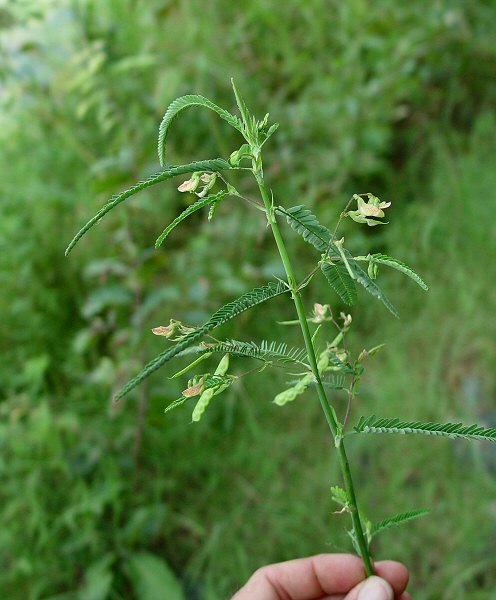Aeschynomene indica L.
Indian Jointvetch

Introduced
CC = *
CW = -3
MOC = 6
© DETenaglia
Aeschynomene indica L.Indian Jointvetch | |
 |
Introduced CC = * CW = -3 MOC = 6 |
© DETenaglia |
|
Family - Fabaceae/Faboideae Habit - Robust annual forb. Stems - Ascending to erect, to 2 m, often branched, glabrous or nearly so.
Leaves - Alternate, sensitive to touch, even-pinnately compound, short-petiolate. Stipules conspicuous but deciduous. Petioles to 8 mm. Leaflets subopposite, oblong, oblique at the base, mucronate, the margins usually entire, the surfaces glabrous, but the undersurface often minutely gland-dotted, 1-veined.
Inflorescence - Few-flowered racemes, sometimes appearing as loose stalked clusters, spreading to somewhat pendant, sometimes with 1 to several small pinnately compound leaves toward the base of the stalk, the stalk often glandular-hairy and sticky, the bracts subtending the flowers similar to the stipules but often smaller.
Flowers - Calyces appearing 2-lipped, the tube short, the upper lip entire or 2-lobed, the lower lip entire or 3-lobed. Corollas papilionaceous, glabrous, yellow to orange, sometimes striped or tinged with red or purple; the banner broadly ovate to nearly circular; the wings narrowly obovate; the keel boat-shaped. Stamens 10, the filaments all fused, the tube split on 1 side or more commonly deeply on 2 sides into 2 groups of 5 stamens each. Ovary linear, short-stalked, often hairy, the style glabrous, curved, the stigma small and terminal.
Fruits - Loments 3.5-4.5 cm long, 4-5 mm wide, the stalk 3-6 mm long, the surfaces sparsely pustular-hairy, usually smooth, with medial lines of minute, pustular-based, warty projections to 0.2 mm long, dehiscent into into 5-9 segments, these 4-5 mm long, 4-5 mm wide. Seeds 3-4 mm long, 2-3 mm wide, olive brown.
Flowering - July - October. Habitat - Ditches, marshes, swamps, pond and lake margins. Origin - Native to the tropics of North America. Lookalikes - A. rudis. Other info. - This species was first reported from Missouri in 1975, from Mingo National Wildlife Refuge. It is more common in states south and east of Missouri. The plant can be identified by its erect stems, many leaflets per leaf, and stiped fruits. The leaflets range in size and have a single midrib. The flowers are pale yellow and the fruits have segments ranging in size from 4-5mm wide. Photographs taken at Arkansas Post National Memorial, AR., 8-31-06. |